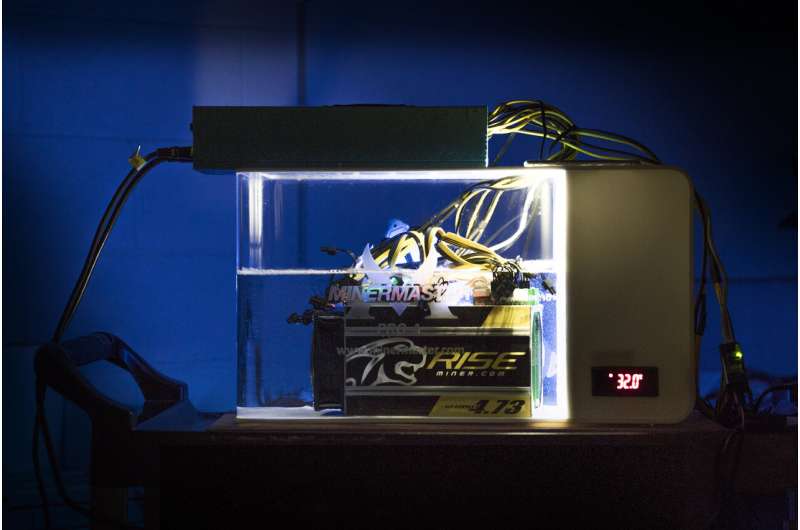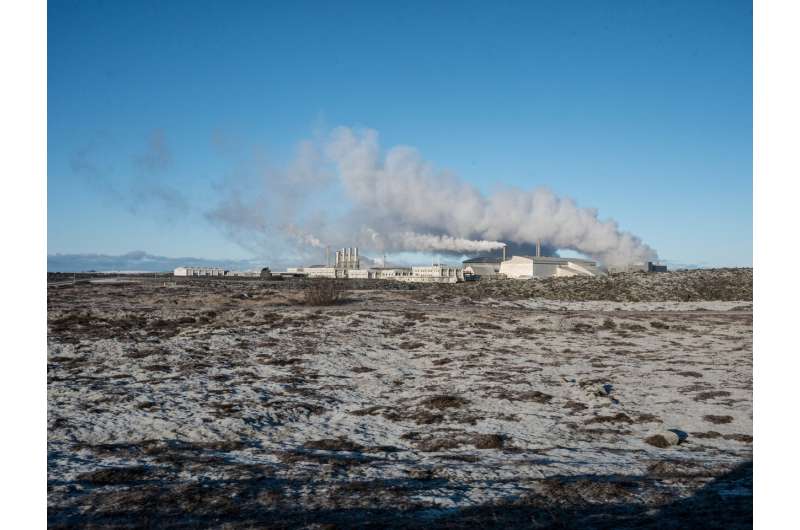Exploring cryptocurrency and blockchain in Iceland

Imagine a hairdryer running on high, continuously, for 24 hours a day, seven days a week. The energy it drains—about 40 kilowatts per hour—equals what one extremely powerful specialized computer uses to mine cryptocurrency. A single six-building data center outside a small town in northern Iceland houses nearly 30,000 of these machines.
"That town of about 900 people, called Blönduós, uses about 1,500 kilowatts of energy per hour, on average. The data center uses 32,000," says Zane Griffin Talley Cooper, a doctoral student in Penn's Annenberg School for Communication. "That data center also has its own dedicated connection to the nearby hydroelectric power plant, which itself is growing in anticipation of industrial expansion into northern Iceland."
On its face, Iceland seems an ideal setting for the fast-growing cryptocurrency industry. The country uses 100 percent renewable energy that's relatively cheap to access. Its climate acts as a natural coolant for continuously running machines that heat up quickly. And to date, the political environment there has mostly welcomed this industry.
But despite those facts, Cooper has questions, not about what cryptocurrency is or does, but about what it requires. "How does it work on the ground?" he asks. "What must be in place for cryptocurrency to happen in a given setting and what about the people involved in building and maintaining the system?"
A multimodal exhibit Cooper created with Annenberg technologist Kyle Cassidy and doctoral student Katie Gressitt-Diaz of Rutgers aims to answer some of these questions through a virtual reality (VR) documentary film, a photo series, and conceptual sound work. It also brings people face to face with a fully operational cryptocurrency mining machine, called an application-specific integrated circuit or ASIC. The intent of the exhibit, on display in the Annenberg Forum through May 2020, is to convey an ethnographic exploration of cryptocurrency and blockchain in Iceland and to spur thinking and conversation about their energy use.
Cryptocurrency cipher
Without understanding the nuts and bolts of cryptocurrency, the subject can seem, well, cryptic. Part of the confusion, according to Cooper, is the word "mining" attached to it. "It's not something that already exists that you find," he says. Rather, it's a sort of transaction-verification process and subsequent reward for that authentication, in the form of a finite number of untraceable electronic coins.
Cassidy likens it to a ledger book. "All of the people who are mining cryptocurrency, they're watching that ledger and making sure no fraudulent entries are put in. At intervals decided by each currency's creator—and there are thousands of cryptocurrencies—a coin is generated and given to one of those people as a reward." A verified transaction then typically gets added to a block, which joins other blocks to form a chain known as the blockchain. "The blockchain is the history of all transactions on that particular network, ever," Cooper explains. "And, in theory, it can't be erased."
The verification process itself is complicated. It requires generating a very particular number that, when added to the data already in the block, produces just the right number of zeros in a row, something impossible for humans to solve. That means the more computing power, the better. When Bitcoin, the first cryptocurrency, came on the scene in 2009, nearly anyone could verify transactions on a regular old laptop. But as more coins started to circulate, meaning more puzzles to solve, that soon wasn't enough computing power.
"People moved to desktops, then to graphics cards, stringing them together," Cooper says. "Then that wasn't enough, so companies started creating what's essentially a motherboard built for a single purpose, to mine Bitcoin. It used to be that you could make a profit with just one, but all of a sudden, four wasn't enough. You had to get seven, 10. Then you had mining pools, where people would link a bunch of machines together in the hopes of getting pieces of a coin. These mining pools grew, and then large data centers started being built, first in China, then in other places—like Iceland."
Iceland as case study
For the past year, Cooper has been thinking about cryptocurrency in Iceland within the broader context of his research, which focuses on how our digital world depends heavily on what he describes as "regimes of resource extraction and energy production." In fall 2018, he started contemplating a trip to experience and document how Iceland's natural resources move from the earth to the ASICs, and who is involved in that process. He asked Cassidy to come take pictures and enlisted Gressitt-Diaz, who studies sonic representation in media at Rutgers, to construct conceptual sound pieces, do field recording, and design an audio mix for the documentary.
In 2019, the trio visited Iceland twice, once in March, a second time in July. They met with blockchain and cryptocurrency industry insiders, environmental activists, two members of the Icelandic parliament, and several people in the energy industry. They toured a geothermal energy facility and a data center.

They learned a great deal. "Being in these spaces is so wild because you can hear what they sound like. It doesn't jive with the images portrayed on Instagram," says Gressitt-Diaz. "You're hearing traffic, the sound of drones flying overhead. There are all of these sounds, of tourists chattering, machine sounds, the hum of powerlines, what I refer to as 'dirty noises' that are there and real and part of the sonic identity of Iceland. But they don't come across when you're looking at idyllic images of Iceland on Instagram."
Technology is everywhere, too. Gressitt-Diaz recalls experiencing this even on a deserted road on a relatively empty part of the island.
"We pulled over at one point on top of this hill," she says. "There was a wide-open space where you could look out onto this vista, land as far as the eye can see. There was nothing around except power lines, and they were really loud, this technology connecting people on the island to power, to electricity. Even in this spot in the middle of nowhere, you could hear the presence of people and their machines."
The resulting exhibit
From that time in Iceland came the exhibit now on display in the Annenberg Forum, "Alchemical Infrastructures: Making Blockchain in Iceland." Cooper's part is a 40-minute, two-part VR documentary film that visitors experience with Google Cardboard viewers, a 360-degree ethnographic examination of cryptocurrency landscapes in Iceland. The film blends multiple environments into single spaces in an attempt to show how different infrastructures and ecologies mix and depend on each other in complex ways.
"You have Iceland's active geology, which is the foundation of all of this. If Iceland wasn't at the intersection of two tectonic plates, then geothermal energy wouldn't be so prominent there," Cooper says. "You have the energy industry, which is involved in tapping into that geothermal energy. Then you have the blockchain companies, which have set up real estate and are negotiating with the energy companies. Plus, you have the environmental angle."
"With this film," he adds, "I'm trying to allow people to feel the geography of it all."
Cassidy's portion consists of 10 portraits. There's one of someone who survived a volcanic eruption and another of a powerplant manager, plus photos of cryptocurrency managers and an environmental activist, among others. "I wanted to make my part of the story about these individuals, the faces of these people who are part of this along the way," he says. "That made it real for me."
With her soundscape, called "Icelandland," Gressitt-Diaz says she wanted to showcase just how entangled technology and nature, the environment and people are. "I hope people will come away from the piece understanding how the use of technology in Iceland has a profound and sometime irreversible effect on nature," she says. "If we continue to allow big industry to take advantage of that great energy resource, nature will continue to suffer until it's too late."
The final component of the show is a fully functional ASIC, specifically a Bitmain Antminer S7 that's actively mining Auroracoin, the unofficial national cryptocurrency of Iceland. The machine is so loud when turned on that it must be submerged in mineral oil to stay cool and be suitable for a public space. Etienne Jacquot, an Annenberg IT support specialist, was the lead engineer responsible for setting up the Antminer and connecting it to the network. He maintains the energy and revenue displays at the exhibit and manages the digital Auroracoin wallet.
The ASIC will run continuously during the course of the exhibition, costing roughly $2 a day in electricity. In just about a month, it earned 123 Auroracoins which, at current exchange rates, comes in at about $3.16.
But Cooper and the others are much more interested in energy consumed than coins earned. Because if the process to put on the exhibit taught them anything, it's that blockchain and cryptocurrency can succeed, but often at great cost to the environment, even in a place that runs on 100 percent renewable energy. When the S9 version of the Antminer was released, for example, S7s suddenly became too slow, making them mostly obsolete and likely destined for a landfill.
"This exhibit is intended to open people's minds to what this system looks like. It's the beginning of something, not the end product," Cooper says. "I don't know if we should or shouldn't build a world out of blockchain—I think it has a lot of promise—but we need to account for all of these negotiations between the environment, energy infrastructure, and social and political infrastructure. Then maybe some good can come of it."





















